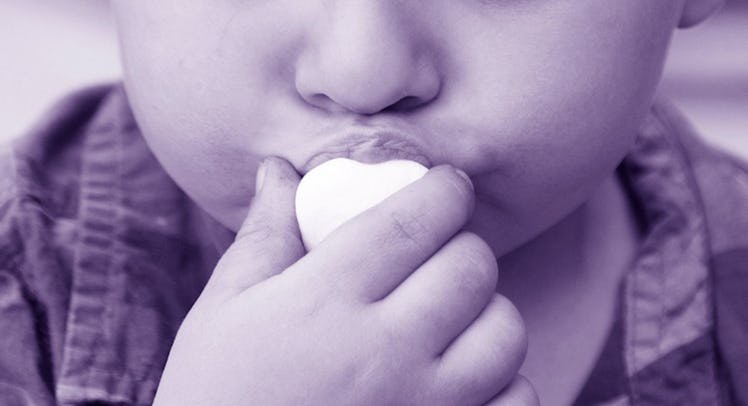How To Measure Your Child’s Impulse Control And Likelihood Of Success
If there’s one factor that predicts success reliably, it’s probably impulse control. Here's how you can test your child's ability to delay gratification at home.

There aren’t a lot of great ways to predict a child’s odds of success. It helps to start off rich, sure. And it doesn’t hurt to have active parents and a stable family. But doesn’t it seem that some people just have the “right stuff”? We all know the type. CEOs who sort of looked like ranking officers in their high school yearbooks. Athletes who have been able to knock one out of the park since tee ball. Scientists who, even in grade school, never missed a homework assignment.
If there’s one factor that predicts success reliably, it’s probably impulse control. Children who learn to delay gratification for long-term rewards will study rather than play video games, practice rather than play, and seem to have a leg-up when it comes to developing into responsible movers and shakers. The trend holds across social and racial demographics. And it’s hardly intangible. Scientists have developed methods of measuring a child’s impulse control that predict success later in life. You can try one of them at home. All you need is a bag of marshmallows, a stopwatch, and a child old enough to understand basic verbal commands.
How To Conduct The Marshmallow Test
Bring your child into a room, empty of distractions, and place a favorite treat (literal marshmallows are unnecessary) on the table. Tell your child that he or she may eat the treat right now without any consequences. But advise your kid that you’re going to leave the room for 15 minutes and, if the treat is still uneaten when you return, the reward is two treats.
Now, you wait.
This test of delayed gratification was developed by Stanford University in 1972, and has come to be known as The Marshmallow Experiment, even though it frequently involved pretzels and animal cookies. The original study involved a small sample of 32 children between the ages of three and five (three kids were booted from the iconic study for failing to follow instructions, presumably after gorging themselves on unearned animal crackers). Since then, the experiment has been replicated at least 20 times. The most recent study was published in 2017.
There were children who responded to the challenge by covering their eyes or turning around so they could not see their yummy temptress. Others kicked the desk and pulled at their hair. Some even adopted the marshmallow as a fluffy white friend and petted it soothingly. Of course, some gobbled it right up. Most lasted five minutes. But a select few survived 900 agonizing seconds.
Across all studies, those rare preschool heroes who made it through the marshmallow crucible went on to obtain higher SAT scores and maintain lower BMIs. They had lower rates of addiction, lower divorce rates, and were more likely to succeed in the workplace. In a word, they were more likely to succeed throughout their lives. (We would be remiss if we did not mention that one of the top editors at Fatherly attributes his success in life to the fact that he took the marshmallow test as a child, and refused to give in even after 15 minutes).
Well, My Kid Ate It Instantly. Should I Start Saving For Retirement?
Absolutely, but not because of the marshmallow test. First of all, if you’re conducting this experiment at home you’re hardly doing so under laboratory conditions. Besides, you’re not a faceless experimenter—you’re a dad. The results are going to be skewed if your kid thinks he’s getting a second marshmallow anyway (and, be honest, you totally gave him one. For shame!).
But it may be a sign that you need to teach your kid a thing or two about delayed gratification. Impulse control isn’t always innate, and it can be learned. Unfortunately, the best way to teach your kids about delaying gratification is demonstrating it yourself. Which is never fun.
Aren’t We All Doomed Anyway? Society Is Bad At Delaying Gratification!
True, it’s gratifying (see what we did there?) to rant about how millennials and their gadgets are ruining the world, and speculate that iPhones have ruined this generation. But studies suggest that’s simply not the case. One recent paper on the marshmallow experiment found that—despite the fact that 84 percent of cognitive development experts think that kids are worse at delaying gratification—children now score higher than ever before on marshmallow tests.
This particular study estimates that, each decade, the average amount of time children have waited before eating their marshmallows has increased by about one minute. And each year since 1972, children have been able to delay gratification for about six more seconds. It’s unclear why, but one clue may be that children’s IQs appear to be increasing at a similar rate.
Perhaps we’re getting smarter, more patient, or simply better at resisting marshmallows. Regardless, the findings ring as true in 2017 as they did in 1972. If you want to teach success, teach your children to wait. And if you want the message to get across, demonstrate it yourself.
…Did you just finish that entire bag of marshmallows by yourself? Nice.
This article was originally published on